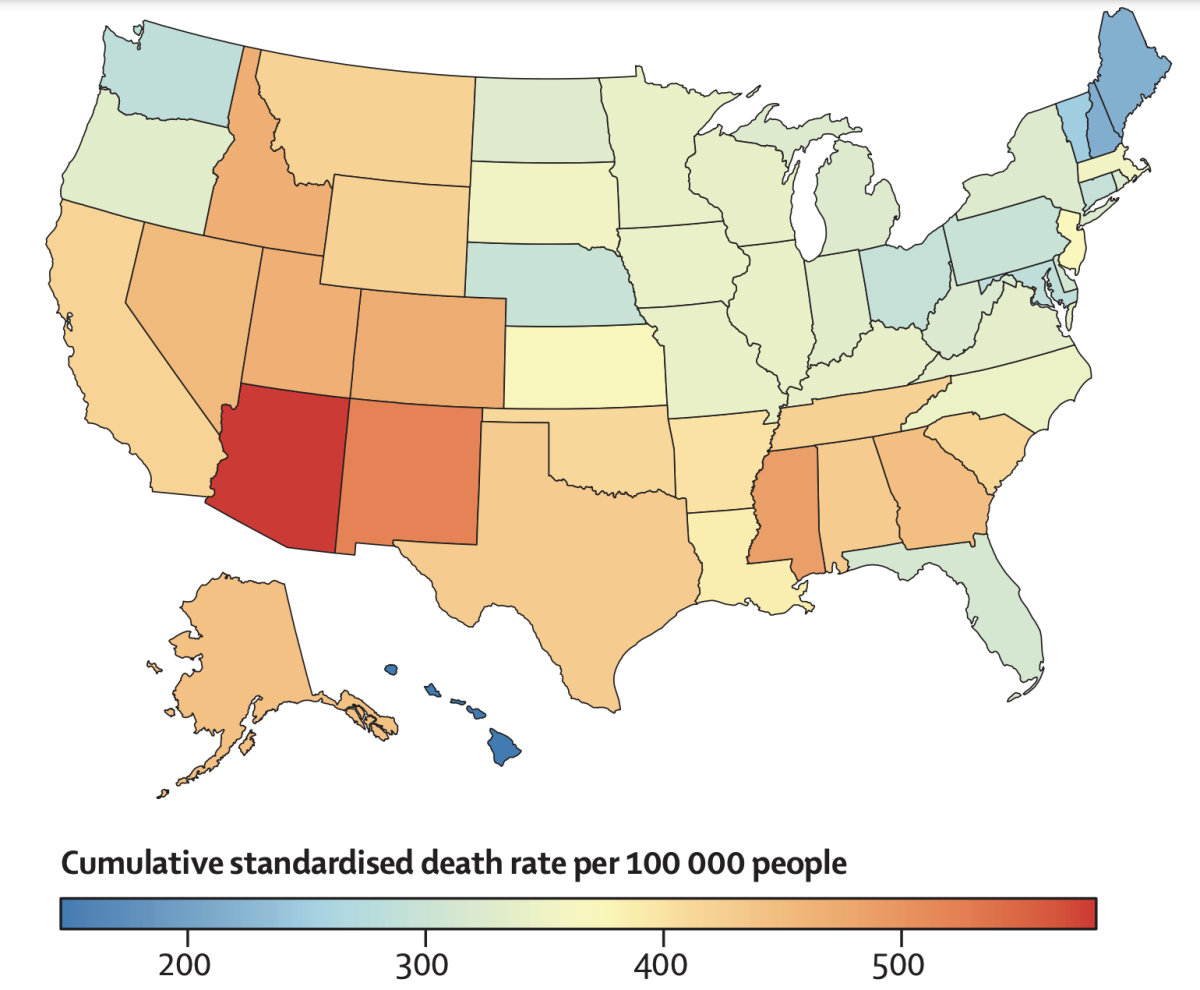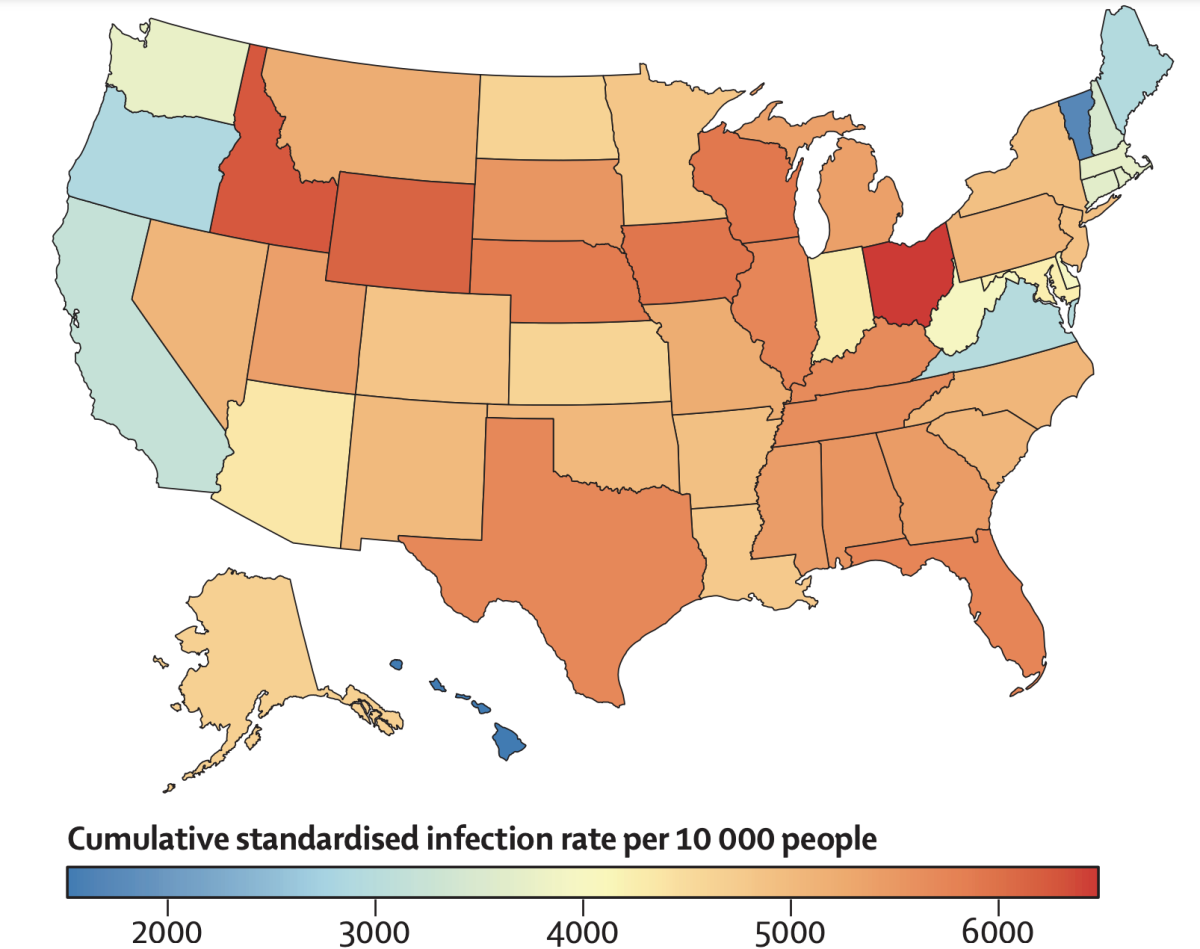The USA has the doubtful distinction of struggling the very best COVID-19 mortality fee among the many world’s high-income nations. However that nationwide common — 372 deaths per 100,000 folks as of final summer season — hides the truth that pandemic outcomes differed tremendously from state to state.
In a comparability that managed for demographic variations between states, Arizona’s COVID-19 mortality fee of 581 deaths per 100,000 residents was nearly 4 instances larger than Hawaii’s, the place there have been 147 deaths per 100,000 residents. Demise charges within the hardest-hit U.S. states resembled these of nations with no healthcare infrastructure no matter. States that fared greatest had charges on a par with nations equivalent to Australia, New Zealand and South Korea, which labored zealously to maintain their pandemic demise tolls low.
What accounts for these large disparities? A new study gives some intriguing solutions.
Race, ethnicity and socioeconomic components have been probably the most highly effective predictors of a state’s COVID-19 demise toll, researchers discovered. The bigger the proportion of residents who recognized as Black or Latino, the upper the poverty fee, the better the share of residents with out medical health insurance and the decrease the schooling degree amongst adults, the extra deaths there have been per capita.
That will not be a lot of a shock. However the researchers additionally found that the extra folks in a state trusted one another, the decrease their collective danger of dying of COVID-19. That end result underscores how America’s growing divisiveness appears to have made us uniquely weak in the course of the pandemic.
“How we really feel about each other issues,” stated political scientist Thomas J. Bollyke, one of many research’s lead authors. “The solidarity between folks — the sensation that others may also do the suitable factor, that you just’re not being making the most of — is an enormous driver in your willingness to undertake protecting behaviors.”
The report, printed final week within the medical journal Lancet, relies on troves of U.S. pandemic information from January 2020 to July 2022. Bollyke referred to as the enterprise “probably the most complete assertion up to now on the drivers of outcomes within the pandemic.”
Scores of researchers from throughout the nation extracted information on states’ demographic traits previous to the pandemic, searching for methods during which their behaviors and insurance policies diverged because the pandemic proceeded. To make direct comparisons between states, they created standardized measures of an infection and demise charges that accounted for variations in COVID-relevant components such because the ages and underlying well being circumstances of residents.

A map evaluating cumulative COVID-19 mortality charges by state, standardized to account for variations within the ages and underlying well being circumstances of residents.
(Bollyky et. al., The Lancet)
For example, California’s unadjusted fee of 291 COVID-19 deaths per 100,000 residents was decrease than all however 11 states. However as soon as analysis factored in that the state has a comparatively younger inhabitants with a low prevalence of circumstances that make folks weak to extreme circumstances of COVID-19, the mortality fee rose to 418 deaths per 100,000 residents. Solely 15 states fared worse, the research authors discovered.
Demographics advised solely a part of the story. Coverage selections mattered too.
Most states adopted some form of masking and social distancing mandates early within the pandemic, however there was large variation on how stringent they have been and the way lengthy they lasted. When the researchers assigned every state a “mandate propensity,” they discovered that states that scored excessive of their imposition of public well being measures had decrease coronavirus an infection charges.
California had the very best mandate propensity, whereas Oklahoma had the bottom. The researchers calculated that if Oklahoma had embraced masking and social distancing restrictions to the identical diploma as California, Oklahoma would have seen 32% fewer coronavirus infections.
Nevertheless, extra aggressive public well being mandates didn’t translate into decrease mortality charges. The authors surmise that’s in all probability defined by the truth that many older and sicker folks, who have been more than likely to die if contaminated, took steps to guard themselves whether or not or not their state governments issued strict guidelines.
The researchers additionally discovered {that a} state’s mandate propensity had no bearing on the well being of its financial system, as measured by its gross domestic product. States with much less masks use and fewer restaurant closures did have larger employment ranges, however that further financial exercise got here at a value: Every percentage-point enhance in a state’s employment was related to 143 extra deaths per 100,000 residents.
No single issue was extra necessary than “vaccinated particular person days” — a measure of how a lot of a state’s population was vaccinated, and the way early. If Alabama, which had the bottom rating on that measure, had achieved the vaccine protection seen in Vermont, the highest-ranking state, it might have seen 30% fewer infections and 35% COVID-19 deaths in the course of the research interval, the researchers estimated.
One other notable discovering: Vaccination mandates for state workers, which prompted many authorized challenges, “stood out” for his or her affiliation with decrease infections and fewer deaths, the authors wrote.

A map evaluating the cumulative fee of coronavirus infections by state, standardized to account for variations in inhabitants measurement.
(Bollyky et. al., The Lancet)
The research highlights the tangible toll of the nation’s us-versus-them mentality, which was on full show throughout debates over masking in schools and vaccine mandates for government employees. We don’t belief each other very a lot, which makes us much less keen to do issues to protect one another.
“Interpersonal belief” has been measured for the reason that Fifties, and ranges of that optimistic feeling towards others have declined steeply in the United States for the reason that early Nineteen Nineties, stated Bollyke, who directs the Global Health Program on the Council on Overseas Relations. That development has been pushed by a decline in financial circumstances for lower-income folks with school levels. It’s significantly low amongst Black People, and amongst those that voted for Donald Trump within the 2020 election.
Belief within the federal authorities and belief in science didn’t register as main drivers of COVID-19 demise charges. However belief in fellow residents held up strongly, Bollyke stated.
The associations the research uncovered clearly counsel that the strengths and weaknesses that states take right into a nationwide emergency — and a number of the insurance policies they undertake to answer a disaster — make an enormous distinction, stated Lawrence Gostin, an professional in public well being regulation at Georgetown College.
“It is a sturdy vindication of states that took COVID significantly, that used science and that mitigated well being inequalities,” Gostin stated. “Plenty of the political rhetoric — that mandates don’t work, and that fairness is just not necessary — was simply confirmed improper.”
The research’s findings could be put to make use of to save lots of lives lengthy earlier than the subsequent pandemic, stated Dr. Steven Woolf, a researcher at Virginia Commonwealth College who tracks the well being standing of People.
“Lots of the similar components are affecting well being outcomes proper now,” Woolf stated.





